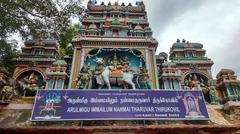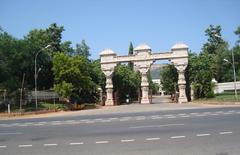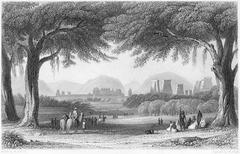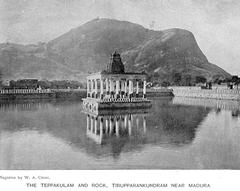
Thiru Aappanoor Madurai Visiting Hours, Tickets, and Historical Guide
Date: 04/07/2025
Introduction
Thiru Aappanoor Temple, located in the heart of Madurai, Tamil Nadu, is a revered Shaivite shrine renowned for its ancient heritage, Dravidian architecture, and vibrant religious traditions. Dedicated to Lord Shiva as Aappudayar, this temple is not only a center of spiritual devotion but also a living testament to the city’s historical and cultural evolution. With origins tracing back to the early Pandya dynasty, Thiru Aappanoor boasts a harmonious blend of architectural influences, artistic treasures, and dynamic community festivals. Its significance is further heightened by legends of divine intervention, especially Shiva’s role in protecting Madurai during a catastrophic flood.
This guide offers a comprehensive overview covering the temple’s historical background, architectural highlights, religious significance, major festivals, visitor information, accessibility, responsible tourism practices, and practical travel tips. Whether you are a pilgrim, history buff, or cultural explorer, this resource will help you plan a meaningful visit to Thiru Aappanoor.
Table of Contents
- Historical Background
- Religious Significance
- Temple Layout and Architectural Highlights
- Major Festivals at Thiru Aappanoor
- Visitor Information
- Getting to Thiru Aappanoor
- Local Context, Facilities, and Responsible Tourism
- Nearby Attractions
- FAQs
- Visuals and Media
- References
Historical Background
Ancient Origins and Pandya Patronage
Thiru Aappanoor traces its origins to the early Pandya dynasty, dating back to the 7th–8th centuries CE. Inscriptions in Tamil and Sanskrit attest to generous endowments and renovations supported by both Pandya and Nayak rulers, emphasizing the temple’s enduring centrality in Madurai’s religious landscape (TempleGyan).
Architectural Evolution
The temple exemplifies Dravidian architectural grandeur, featuring towering gopurams (gateway towers), spacious mandapams (pillared halls), and an expansive temple tank used for ritual purification. Renovations by the Nayaks introduced elaborate stucco work and vibrant polychrome sculptures, further enhancing the temple’s visual appeal (Way2Travels).
Inscriptions and Literary References
Thiru Aappanoor is immortalized in classical Tamil literature, with Saivaite saints like Appar, Sundarar, and Sambandar extolling its sanctity. Stone inscriptions detail donations, renovations, and the temple’s role in local religious practices (MantraPuja).
Religious Significance
The Legend of Aappudayar
Central to the temple’s identity is the legend of Shiva as Aappudayar, who acted as a divine wedge (“aappu”) to protect Madurai’s fort gates from a devastating flood. This mythological act of protection is celebrated in the temple’s rituals and forms a thematic core for major festivals (Indianetzone).
Rituals and Festivals
Daily worship follows Shaiva Agamic traditions, featuring multiple pujas, abhishekams (ritual bathing), alangaram (decoration), and deepa aradhana (waving of lamps). Major festivals like Brahmotsavam and Panguni Uththiram draw large crowds and involve elaborate processions, music, and communal feasts.
Temple Layout and Architectural Highlights
Thiru Aappanoor’s architecture is organized along cardinal directions, with the sanctum sanctorum (garbhagriha) at its core, surrounded by concentric prakarams (corridors). The east-facing main gopuram is adorned with brightly painted stucco figures narrating epics and local legends. Mandapams feature finely carved granite pillars and frescoed ceilings, while subsidiary shrines honor Parvati, Ganesha, Murugan, and the Navagrahas. The temple tank, bordered by stone steps and colonnaded corridors, is central to ritual and festival activity (hindu.mythologyworldwide.com; travel.india.com).
Major Festivals at Thiru Aappanoor
- Brahmotsavam (Maasi Brahmotsava): Held in February–March, this grand festival features flag hoisting, daily abhishekams, special pujas, and processions of silver festival idols on ornate vahanams.
- Panguni Uththiram: Celebrated in March–April, it includes the ritual crossing of Meenakshi and Sundareswarar’s festival images from Meenakshi Temple to Thiru Aappanoor.
- Pradosham: Observed bi-monthly, with processions, abhishekams, and lamp lighting.
- Navaratri: The temple is decorated for nine nights, with daily pujas and cultural programs.
- Other Festivals: Includes Aadi Perukku, Aadi Amavasai, Aadi Pooram, and other local and seasonal observances (Drik Panchang Tamil Calendar).
Visitor Information
Visiting Hours
- Standard Timings: 6:00 AM – 12:30 PM; 4:00 PM – 8:30 PM daily.
- Festival Periods: Timings may adjust; verify in advance with the temple or local tourism offices (Wandering Heritager).
Entry Fees
- Admission: Free for all visitors.
- Special Rituals: Offerings or abhishekam sponsorships require a nominal fee at the temple office.
Accessibility
- Wheelchair Access: Ramps are available at entrances; assistance is provided for inner sanctum access, which may have steps.
- Facilities: Drinking water, restrooms, and shoe-keeping areas are provided near the entrance.
Guided Tours and Photography
- Guided Tours: Available through local guides and Madurai tourism offices; advance booking recommended for festival periods.
- Photography: Permitted in outer courtyards and gopurams, but restricted in the sanctum and during rituals. Always seek staff guidance.
Dress Code and Etiquette
- Modest Attire: Men should wear dhotis or trousers and shirts; women should wear sarees or salwar kameez. Shoulders and knees must be covered. Footwear must be removed before entering.
Best Time to Visit
- Weather: October–March offers pleasant conditions.
- Festivals: Brahmotsavam and Panguni Uththiram are the most vibrant periods but can be crowded.
Getting to Thiru Aappanoor
Location
- Address: Sellur, Madurai, Tamil Nadu – North bank of the Vaigai River, approx. 2 km from Meenakshi Amman Temple (Indianetzone).
Transport Options
- Public Transport: Town buses (17, 17A, 17C) from Periyar Bus Stand; autos and taxis from Madurai Junction (3–4 km away); direct taxi or app-based rides from Madurai International Airport (12 km).
- Private Vehicle: Parking is available, but limited during festivals.
- Walking/Bicycle: Convenient from nearby city landmarks.
Local Context, Facilities, and Responsible Tourism
Neighborhood Overview
Sellur is a lively area reflecting Madurai’s traditional culture, with nearby markets, eateries, and pooja shops. The community is welcoming, often sharing insights with visitors.
Responsible Tourism Tips
- Support Local Vendors: Purchase pooja items and snacks locally.
- Environmental Care: Avoid single-use plastics, use refillable water bottles, and minimize waste.
- Cultural Sensitivity: Dress respectfully, follow temple protocols, avoid disrupting rituals, and participate in sustainable tourism initiatives (Responsible Tourism Partnership; Green Tourism World).
Nearby Attractions
- Meenakshi Amman Temple: Iconic landmark, 2 km away.
- Thirumalai Nayak Palace: Majestic 17th-century palace.
- Gandhi Memorial Museum: Insight into India’s freedom struggle.
- Vandiyur Mariamman Teppakulam: Sacred temple tank.
- Local Markets: Explore Madurai’s culinary and flower markets.
Frequently Asked Questions (FAQs)
Q: What are Thiru Aappanoor’s visiting hours?
A: 6:00 AM – 12:30 PM and 4:00 PM – 8:30 PM daily.
Q: Is there an entry fee?
A: No, entry is free; donations are welcome.
Q: Are guided tours available?
A: Yes, through local guides and tourism offices. Book in advance, especially during festivals.
Q: Is the temple accessible for wheelchair users?
A: Most areas are accessible; some inner sanctum steps require assistance.
Q: Can non-Hindus visit?
A: Non-Hindus are welcome to observe rituals; some inner areas may be restricted.
Q: Is photography allowed?
A: Only in outer areas; prohibited in sanctum and during rituals.
Q: How do I reach the temple?
A: By bus (routes from Periyar Bus Stand), auto, taxi, or on foot from central Madurai.
Visuals and Media
- Aerial view of Thiru Aappanoor Temple with the Vaigai River (alt: “Aerial view of Thiru Aappanoor Temple, Madurai historical site”)
- Visitors removing footwear at the temple entrance (alt: “Visitors removing footwear before entering Thiru Aappanoor Temple”)
- Close-up of temple carvings (alt: “Intricate carvings at Thiru Aappanoor Temple in Madurai”)
- [Embedded map showing temple location relative to Meenakshi Amman Temple and transportation hubs]
Conclusion
Thiru Aappanoor Temple stands as a remarkable symbol of Madurai’s spiritual and cultural heritage. Its architectural splendor, legendary origins, and dynamic festivals offer a unique window into Tamil Nadu’s rich religious traditions. With free entry, accessible facilities, and proximity to key city landmarks, Thiru Aappanoor is a must-visit for pilgrims and travelers alike. By embracing responsible tourism and supporting local communities, visitors help preserve this sacred legacy for generations to come.
For updated details, festival dates, and real-time tips, download the Audiala app and explore additional resources for Madurai’s historic sites.
References
- Meenakshi Temple Madurai: Timing, Location, Stay Options and History – TempleGyan
- The Majestic Meenakshi Temple in Madurai – Way2Travels
- History of Meenakshi Amman Temple in Madurai – MantraPuja
- Aappudayar Temple - Thiru Aapudaiyar Koil – Wandering Heritager
- Thiru Aappanoor Temple – Indianetzone
- ICRT India Network – Responsible Tourism Partnership
- Sustainable Tourism in India – Green Tourism World




